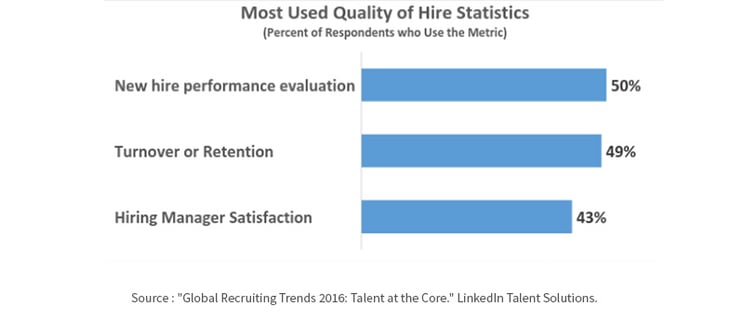
In our recent reading about recruiting trends for 2016, we found that quality of hire is still a hot topic and one of the biggest concerns of business leaders. So much so the Society for Human Resources Management (SHRM) calls it the holy grail.
We also find little confidence in the validity of the measurement. In LinkedIn’s Global Recruiting Trends 2016 survey, only 33% of recruiting professionals believe they have effective measures. The following chart shows the top three statistics used in quality of hire measurement.

The Credibility Gap
It’s easy to see why credibility is an issue. We have little trust in these measures.
- New hire performance evaluation. Most companies don’t trust their performance evaluation process. Only 8% believe it adds value. Not only that – most companies measure performance in the first 90 days, and takes most employees up to a year to become fully productive.
- Turnover or retention. We doubt new hire turnover is a measure of quality of hire. It is more likely a measure of the quality of both the onboarding and training process and company culture.
- Hiring manager satisfaction. Does it make sense to ask the person who made the hiring decision to rate the recruiter on the quality of that decision?
Ji-A Min, Research Analyst at Ideal Candidate, recommends the commonly used mix of 90-day turnover rate, ramp-up time, performance data, employee engagement, and cultural fit based on 360 ratings. Here is Min’s calculation:

At face value it makes sense, but is it credible?
Examine Assumptions in Your Metrics
When in doubt, ask an expert. We talked with Stephen Pollan, CEO of Assessment Technologies Group about the credibility issue. ATG is a group of psychologists who use science and technology to help companies hire the right people, strengthen leadership, and improve organizational performance. Pollan cited two reasons CHROs have difficulty finding valid measures for quality of hire:
- Many HR leaders are generalists who got into HR by default because they can manage the administrative functions in HR. Tasked with measuring their talent management activities, they find a solution that appears credible, but they don’t understand the underlying factors. Pollan tells us why: just as in accounting, there is a set of acceptable practices in the profession which withstand scrutiny. People often accept these metrics on face value.
- The second reason is that companies hire people based on a managerial culture that doesn’t fit reality. Employees run into difficulty when they run up against managerial style, and when they don’t work out, managers say they don’t fit.
Pollan recommends a holistic view that begins with understanding underlying assumptions. He says that before you place trust in these metrics, you should assess your culture and how you manage people from a managing and hiring perspective. “If you are hiring people for cultural fit, you need to understand your culture first,” he says. “Look at your culture and how you manage people from a managing and hiring perspective.”
A Guiding Principle
Our examination of this metric gives us a principle that should guide us in all our analytics reporting. Our pretty dashboards are only as good as the quality of the underlying assumptions.
Pixentia is a full-service technology company dedicated to helping clients solve business problems, improve the capability of their people, and achieve better results.





Leave a Comment